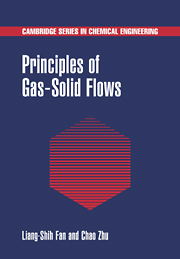Book contents
- Frontmatter
- Contents
- Preface
- Part I Basic Relationships
- Part II System Characteristics
- 7 Gas–Solid Separation
- 8 Hopper and Standpipe Flows
- 9 Dense-Phase Fluidized Beds
- 10 Circulating Fluidized Beds
- 11 Pneumatic Conveying of Solids
- 12 Heat and Mass Transfer Phenomena in Fluidization Systems
- Appendix: Summary of Scalar, Vector, and Tensor Notation
- Index
12 - Heat and Mass Transfer Phenomena in Fluidization Systems
from Part II - System Characteristics
Published online by Cambridge University Press: 27 October 2009
- Frontmatter
- Contents
- Preface
- Part I Basic Relationships
- Part II System Characteristics
- 7 Gas–Solid Separation
- 8 Hopper and Standpipe Flows
- 9 Dense-Phase Fluidized Beds
- 10 Circulating Fluidized Beds
- 11 Pneumatic Conveying of Solids
- 12 Heat and Mass Transfer Phenomena in Fluidization Systems
- Appendix: Summary of Scalar, Vector, and Tensor Notation
- Index
Summary
Introduction
Among many gas–solid flow systems involving heat and mass transfer operations, the fluidization system is one of the most frequently encountered. The heat and mass transfer behavior in a gas–solid fluidized bed is important when physical or chemical operations are conducted in the bed, such as drying, coal combustion, polymerization reaction, and chemical synthesis. The fluidized bed is characterized by a high efficiency of heat exchange between particles and the fluidizing gas. The inherent intensive gas–solid contact or rapid mixing between gas and solid phases contributes to this efficient heat transfer. The fluidized bed possesses high heat capacity, and uniform temperature in the bed can generally be maintained. Thus, temperature control in the bed can be effectively carried out. Comparable characteristics are also exhibited for the fluidized bed mass transfer between gas and particles and between the bed and gas or particles.
The heat and mass transfer properties can be represented by heat and mass transfer coefficients, which are commonly given in empirical or semiempirical correlation form. The transfer coefficient is defined in terms of flow models under specific flow conditions and geometric arrangements of the flow system. Thus, when applying the correlations, it is necessary to employ the same flow model to describe the heat and mass transfer coefficients for conditions comparable to those where the correlations were obtained. An accurate characterization of the heat and mass transfer can be made only when the hydrodynamics and underlying mechanism of the transport processes are well understood.
- Type
- Chapter
- Information
- Principles of Gas-Solid Flows , pp. 499 - 539Publisher: Cambridge University PressPrint publication year: 1998
- 1
- Cited by



